WMO/CAS/WWW
FIFTH INTERNATIONAL WORKSHOP ON TROPICAL CYCLONES
Topic 5.3 : Effective Warnings
Rapporteur : T.C. Lee
Hong Kong Observatory
134A Nathan Road, Kowloon,
Hong Kong.
E-mail : tszclee@hko.gov.hk
Fax : (852) 2377 3472
Working Group Members : Jim Davidson, S. R. Kalsi, Kriengkrai Khovadhana,
H. K. Lam,
Glendell De Souza, Max Mayfield, Rajendra Prasad, Alan Radford,
Jose Rubiera, Michel Rosengaus, Steve Ready, Shourong Wang.
- Introduction
An effective tropical cyclone (TC) warning system requires the warnings and information prepared by the National Meteorological Service (NMS) and Tropical Cyclone Warning Centre (TCWC) to be accurate, disseminated to the designated users in a timely and comprehensive manner, and responded to properly by the emergency organizations and communities at risk. Factors affecting the effectiveness of a TC warning system can be categorized under four main areas:
- Forecast Accuracy and Reliability (Section 5.3.2);
- Warning Dissemination and Presentation (Section 5.3.3);
- Response to Warnings, Public Education and Disaster Preparedness (Section 5.3.4); and
- International and Regional Cooperation (Section 5.3.5).
This report reviews the latest development in these four areas. Potential roadblocks and future opportunities in relation to effective warnings include:(a) Track forecasting of landfalling TCs; (b) TC intensity prediction; and (c) Impact of the internet are discussed in Section 5.3.6.
In addition to the valuable inputs of working group members, this report draws on published and unpublished sources of information, including the Draft “Guidelines on Improving Public Understanding of and Response to Warnings” compiled by Davidson et al. (WMO 2002).
Forecast Accuracy and Reliability
A modern TC warning service should provide accurate and quantitative predictions of high winds, heavy rain, and storm surge. Over- or under-warnings of these hazards will result in socio-economic loss and, to a certain extent, affect the credibility of the NMS or TCWC. An accurate TC forecast track and a good knowledge of the wind and rain distribution of the TC are essential.
- TC Track Forecasting
Forecasters have for a long time pinned their hope on numerical modeling (Bell 1979). Over the last decade, the skill of numerical models in TC track forecasting has improved significantly (JMA 1998; Heming 2000; Lam 2001; Aberson 2001) and forecasters are relying increasingly on the guidance from numerical models that are available via the WMO Global Telecommunication System (GTS)(WMO 1999). As an example, Figure 1 shows the skill scores of the TC track forecast of the UK Meteorological Office (UKMO) global model from 1988-2001. An improving trend can be observed, especially for the 24- and 48-hour forecasts. The better Numerical Weather Prediction (NWP) guidance has resulted in better subjective forecasts issued by NMSs. For example, Figure 2 shows the U.S.A. National Hurricane Center (NHC) yearly-average Atlantic track forecast errors. Trend lines show the largest improvements are at the longer time periods.
Ensemble forecasting techniques are increasingly used in TC track prediction in recent years. The single model ensemble approach defines perturbed initial conditions that represent the uncertainty in the analysis and then integrates the ensemble members with a single model (Aberson et al. 1995; Cheung 2001; Zhang and Krishnamurti 1997). The multiple model ensemble approach makes simple averages of the forecast outputs of several models from different centres. Verifications show that the multiple model ensemble approach results in noticeable improvement in TC forecast track errors (Goerss 2000; Lee and Wong 2002). Carr and Elsberry (2000) also conducted research that relates the large forecast position errors to the models’ excessive prediction of certain categories of synoptic patterns bearing on TC movement. This suggests that a TC track forecasting system can be developed to assist forecasters in selecting the best performing NWP models to construct the ensemble forecast on each occasion (Carr et al. 2001).
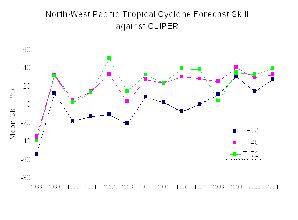
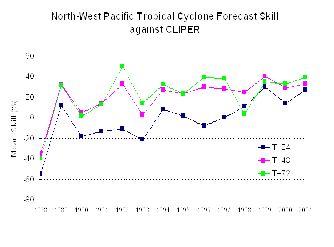
Figure 1 Skill relative to climatology-persistence (CLIPER) of the UK Met Office Global Model TC track forecast from 1988-2001 in western North Pacific. (http://www.metoffice.com/sec2/sec2cyclone/tcver.html)
Figure 2 Yearly-average Atlantic track forecast errors with trend lines at 24-, 48- and 72-hour time periods.
Prediction of Severe Weather and Storm Surges
To predict the time of onset of severe weather and storm surges at specific locations, detailed knowledge of the wind and precipitation structure of the TC (e.g. TC size, gale wind radius) have to be known besides the forecast track. Observations in recent years from advanced sensors (e.g. Tropical Rainfall Measuring Mission (TRMM), Special Sensor Microwave/Imager (SSM/I), Advanced Microwave Sounding Unit (AMSU), and QuikSCAT) on the new generation of meteorological satellites (Kidder et al 2000; Imaoka and Roy 2000; Yeh et al. 2002; Bankert et al. 2002) have increased knowledge on the initial conditions of wind and precipitation fields. Valuable information on wind fields can also be obtained from GPS dropsondes and Stepped Frequency Microwave Radiometers from aircraft reconnaissance. Radar is another important tool in very short-range forecasting of landfalling TCs (Tuttle and Gall 1999; Blackwell 2000). Correlation and extrapolation techniques have been usefully employed to depict the wind structure of TCs and to make very short-range rainfall forecasts (Li et al. 1999; Lai 1999).
For storm surge prediction, the Sea, Lake, and Overland Surge from Hurricane (SLOSH) model (Jelesnianski 1992) is still one of the most popular models used by TCWCs and NMSs (Houston et al. 1999; Tam 1996). A meteorological hazard model, The Arbiter of Storm (TAOS), has also been developed and incorporated into the Caribbean Disaster Mitigation Project (Watson et al. 1999). India Meteorological Department (IMD) has been using locally developed nomograms (Ghosh 1977) and a PC-based storm surge model developed by the Indian Institute of Technology Delhi for storm surge prediction (Dube et al. 1985; Kalsi et al. 2002).
(c)
TC Intensity Prediction
As far as TC intensity prediction is concerned, Dvorak analysis (Dvorak 1984) and NWP guidance are commonly used by NMSs and TCWCs in assessing and forecasting TC intensity. The U.S.A. NHC also uses the Statistical Hurricane Intensity Forecast (SHIFOR) model and Statistical Hurricane Intensity Prediction Scheme (SHIPS) model in predicting TC intensity in the Atlantic and eastern North Pacific (Jarvinen and Neumann 1979; DeMaria and Kaplan 1994). Over the western North Pacific, the Joint Typhoon Warning Centre at Pearl Harbour employs the Statistical Typhoon Intensity Forecast (STIFOR) model and the Typhoon Intensity Prediction Scheme (TIPS) for TC intensity forecasts (Chu 1994; Fitzpatrick 1997).
- Warning Dissemination and Presentation
TC warnings are only useful if they are received by the targeted user in a timely and comprehensive manner. This requires efficient communication channels, effective warning presentation, and user-specific warnings.
- Communication Channels
The choice of communication channels for TC warning dissemination varies from one place to the other depending on the social culture, technology level, communication infrastructure, and local landscape. Many NMSs disseminate warnings via multiple communication channels to maximize coverage. Some of the most widely used channels are described below.
(i) Media (TV, radio, and press)
TV and radio remain the most popular means for the public to receive TC warnings and information. In addition to on-screen warning icons, text crawlers and news breaks, regular briefing conducted by NMS meteorologists on TV can promote the caring image of the NMS and make the public feel that they are receiving the warnings/advice directly from the NMS (Lam 2000). The U.S.A. NHC also institutes an Electronic Media Pool to disseminate warning messages and information to the media. It is an efficient and equitable means for serving the public interest and the media.
Radio (including amateur channels) often becomes the only channel of warning dissemination in remote areas and in many developing countries where communication infrastructure is unreliable in floods and adverse weather.
(ii) Telephone, mobile phone, pager and facsimile
Automatic and interactive telephone answering services enable NMSs to disseminate information and entertain more enquiries in an efficient way. Wireless communication appliances such as the mobile phone, pager and personal digital assistant allow people on the move to obtain information. The Short Message Service (SMS) enables NMSs to deliver warning messages to a large number of mobile phone users, while the wireless application protocol (WAP) allows NMSs to deliver web-based information to mobile phone users (see Figure 3).
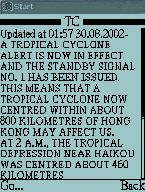
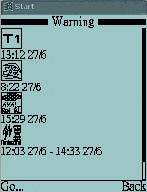
(ii) Telephone, mobile phone, pager and facsimile
Figure 3 Samples of the WAP page provided by the Hong Kong Observatory
(a) warning icons and (b) TC warning messages.
(iii) Internet
The growth of the internet has been phenomenal. The web is one of the most cost-effective means for NMSs to deliver timely, comprehensive and varied information to the public and special users. A total of 4.3 million page visits to the Hong Kong Observatory website were recorded on 11 September 2002 during the passage of Severe Tropical Storm Hagupit. The U.S.A. NHC has also established several mirror websites to cater for the large volume of hits to their websites. URLs of WMO Members’ websites can be found at: http://www.wmo.ch/web-en/member.html. For expedience, special clients and decision makers of emergency organizations can be alerted to the issuance of warnings via emails.
- Forecasting and Emergency management networks
Some NMSs have set up dedicated telephone lines and websites to communicate with other emergency organizations and exchange technical information/expert views with regional/local meteorological communities.
In Australia, the State Emergency Services in New South Wales receives special severe storm warnings with both graphical and textual forecasts of storm tracks through a dedicated website run by the Bureau of Meteorology.
In the U.S.A., a Hurricane Liaison Team (HLT), which consists of federal, state, and local emergency management officials, will be deployed to the NHC to support hurricane response operations and decision making. Video-teleconference briefings are also conducted to enhance the communication between HLT and individual emergency management organizations and response agencies.
The U.S.A. NHC also makes use of a dedicated “Hurricane Hotline” to collaborate with forecasters from local U.S.A. Weather Forecast Offices, U.S. Navy, U.S. Air Force Weather Agency, and National Aeronautical and Space Administration as well as severe weather experts at the Storm Prediction Center, precipitation forecasters at the Hydro-meteorological Prediction Center and hydrologists from River Forecast Centers. The result is a well coordinated forecast from the federal meteorological community prior to the official NHC forecast being issued.
- WMO Global Telecommunication System (GTS)
GTS is still a reliable method for NMSs to disseminate warnings/forecasts to other NMSs and TCWCs. Continuous modernization and improvement of GTS facilities by NMSs are underway. For instance, the New Delhi-Toyko MTN link has been upgraded from 9.6 kbps analog circuit to 64kbps digital circuit.
- Warning Presentation
The diversity of communication channels requires TC warnings and associated information to be presented in different formats suitable for the channels concerned. This refers to content as well as to format. NMSs are responding to this demand.
(i) Warnings in standard text
Text warning messages in fixed, clear and easy-to-read structure continue to work across different communication channels. It is useful to users who perform machine reading of warnings. NMSs have to ensure that changes in warning formats are well publicized before they happen, so that users can prepare for the changes.
(ii) Graphical warning products
Graphical or pictorial products are produced by many NMSs to complement warnings in text. On TV and the internet, graphical products that depict the forecast TC track and extent of affected areas can be animated. Interactive display on the internet is also easily achievable. This increases the likelihood that the warning will be understood and acted upon by the public. Figure 4 shows a TC track and a “cone of uncertainty” produced by NHC, U.S.A.
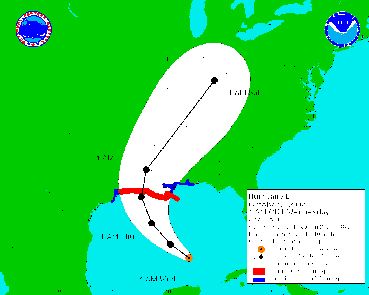
Figure 4 The TC track of Hurricane Lili on 2 October 2002 produced by NHC, U.S.A.
- Probability information
Inclusion of the degree of uncertainty of a forecast is becoming increasingly necessary for tropical cyclone warnings. This allows users to consider the cost of taking protective action versus the potential cost of damage from the hazard.
(iv) Real-time meteorological information
The public accessing weather information is evolving into a diversity of sub-sectors, ranging from the illiterate to the highly intelligent and knowledgeable. At the intelligent and highly weather-literate end of the spectrum, there is greater demand for real-time meteorological data relevant to current weather conditions (e.g. winds, rain, and temperatures). Many NMSs now make available information from automatic weather stations (AWS) on their websites. Some put radar images on their websites as well, which has been found to strengthen the credibility of the NMS.
- Advanced Information for Special Users
Some emergency services as well as operators of public utilities such as airports, ferries, buses, and trains would like to be given advance alert prior to community-wide dissemination of TC warnings, even if it is as short as a few minutes. This allows them to organize and/or mobilize necessary response resources before the public actually reacts to the warnings. This is particularly useful when the public’s reaction to a warning translates immediately into increased demand on public services. Some NMSs have instituted arrangements for making advanced alerts, which are well received by the special users.
(d) Information for Visually Impaired
Some NMSs have implemented audio web pages and interactive telephone answering systems to help the visually impaired to obtain warning messages and related weather information.
- Warning Response, Public Education and Disaster Preparedness
A timely and accurate TC warning does not guarantee it will be successfully acted upon by the public. Studies on the human response to warnings (WMO 1989; Falls 1990; Mileti and Sorenson 1990) indicate that the willingness and ability of the public to respond effectively to warnings is, to a large degree, dependant on how successful the public education campaigns have been and how well the public are prepared.
In recent years, some of the NMSs have recognized that the social aspects of the contents and communication of warnings is just as important as the meteorological content and accuracy. These NMSs are now moving toward a customer-centred approach to service and warning delivery. Warnings are written in an intuitively understandable manner and in such a way that the public could react to and do what is necessary to protect themselves. Some NMSs are also working with social and behavioral scientists to better understand how the public responds to warning messages. Expert advice from social scientists is used to modify the format and presentation of the warnings so as to stimulate an appropriate response.
To promote public awareness and preparedness for TC hazards, public education campaigns have been conducted by NMSs regularly and on an as-needed basis. Some educational materials and initiatives in support of public education campaigns are described below:
(a) Real-time Education
Many NMSs include recommended preparatory and defensive actions in TC warning messages. They are short and simple supplementary messages that advise the public on short-term strategies which will help them to protect themselves and their properties.
- Pamphlets and Leaflets
Pamphlets/leaflets are relatively cheap to produce and distribute widely. Concise information on TC warning systems and precautionary advice are included in the pamphlets using commonly used languages and layman’s terms.
(c) Media Packages (TV, radio, and newspaper)
Educational and preparedness information are published in newspapers and broadcast as brief radio and TV public announcement segments. TV documentaries are also produced to raise the awareness and preparedness of the public toward natural disasters. In India, as a part of the public awareness programme, IMD officers present programmes on tropical cyclones and precautionary measures in regional languages on all India radio and TV.
- Internet
The internet has become an increasingly effective way of delivering hazard awareness education. Detailed educational materials on TCs and related warnings are posted onto the internet by NMSs for public access.
- Meetings, Visits and Exhibitions
Most of the NMSs arrange regular visits, meetings, and exhibitions for schools, local communities, and emergency organizations to familiarize the civilians and experts alike with the TC warning system and to promote precautionary measures. In Australia, NMS staff and key emergency service personnel tour cyclone- and flood-prone areas of northern Australia prior to each wet season to brief the public and stakeholders on TC hazards and the warning and response systems in place. Similar tours are also conducted by staff of the U.S.A. National Weather Service prior to the hurricane season each year.
Moreover, the U.S.A. NHC takes a “Hurricane Hunter” reconnaissance aircraft on a Hurricane Awareness Tour (HAT) each year. The HAT typically makes stops at five TC vulnerable communities and alternates between sites along the Gulf of Mexico and Atlantic coast each year. A Caribbean Hurricane Awareness Tour (CHAT) is also held annually. School children are bussed in from the local communities to tour the aircraft which usually assures excellent media coverage.
Many NMSs also organize Open Days of their facilities. This provides an opportunity for NMS staff to hear at first hand the needs of the public and to give the public a better understanding of forecasting operations.
- School-based Educational Packages
School curricula in most TC-prone countries include some hazard awareness education in both primary and secondary school. Some of the NMSs contribute to the development and publication of these educational materials. Forecasters also pay visits to schools and give presentations to students/teachers regarding TC hazards. For example, the Bureau of Meteorology, Australia, in partnership with the James Cook University Centre for Disaster Studies, has produced an interactive CD-Rom game that informs primary school students about TC hazards and instructs them on appropriate preparatory behaviors.
- Hurricane Awareness Week
In order to promote public awareness, a Hurricane Awareness Week (HAW) has been held in the U.S.A. in 2001 and 2002. The HAW is scheduled prior to the start of the Atlantic TC season. A comprehensive web page, which contains detailed information on TC basics, climatology, hazards and forecast limitations, has been developed to support the HAW (http://www.nhc.noaa.gov/HAW2/index.htm).
As regards disaster preparedness, it is becoming a common practice for NMSs to conduct pre-TC season preparation meetings and post-TC season review meetings with all government or non-government partners participating in the TC disaster contingency plan. These meetings serve to develop and maintain strong partnerships between NMSs and emergency organizations, to help all participating parties understand their respective roles and responsibilities in the contingency plan, and to solve possible problems in the warning-response system. Moreover, NMSs strive to maintain close liaison with the media partners, especially radio and TV, to ensure that the most up-to-date TC warning information can be disseminated to the public accurately, regularly, and with high priority.
- International and Regional Cooperation
Tropical cyclones do not recognize political borders. NMSs need to work together in a spirit of mutual assistance and cooperation to meet increasing demands on the tropical warning services. NMSs are cooperating in the dissemination of TC warnings, exchange of data/information, and the promotion of public awareness on TC hazards. Some recent activities are:
- Severe Weather Information Centre (SWIC)
SWIC (http://severe.worldweather.org/) is a WMO pilot website that disseminates consolidated official warnings and advisories issued by WMO Members through a consistent web interface (Lam 2002). The operational trial of this pilot website commenced on 10 September 2001. The website now covers warnings of tropical cyclones in the western North Pacific provided by Members of the ESCAP/WMO Typhoon Committee. Extension to Region V (South-West Pacific) is in progress.
(b) TC Names in Western North Pacific (WNP)
TCs are named to provide ease of communication between forecasters and the general public regarding forecasts, weather watches, and warnings. They also help to promote public awareness regarding impending TCs.
Over the WNP basin, a new list of TC names has been used since 2000. The list consists of a total of 140 names contributed by 14 countries and territories in the region. (http://www.weather.gov.hk/informtc/sound/tcname2000e.htm).
(c) Information exchange
Besides traditional synoptic observations and TC warning advisories, NMSs, TCWCs, and major research institutes have put much effort in sharing NWP products, “best track” databases, radar images and satellite images as well as scatterometer data over the internet in recent years. To facilitate timely preparation of TC warnings by NMSs/TCWCs, the Japan Meteorological Agency (JMA) and UKMO also disseminate the TC track and intensity forecasts made by their global and typhoon models in standard text format to NMSs/TCWCs via the WMO GTS.
Roadblocks and Future Opportunities
- Track Forecasting of Landfalling TCs
Accurate determination of TC landfall location and timing is the key to the effectiveness of TC warnings/forecasts for a specific region.
- Short-range forecasting
The critical period for some countries/places is the 6-12 hours before TC landfall. In such a short time frame, NWP guidance with an average 12-hour forecast error of about 100 km cannot offer much assistance to forecasters. Very often, forecasters have to subjectively nowcast the TC movement in the next 6 hours based on radar images and limited synoptic/AWS data. Significant error in landfall location and timing could result if the TC moves erratically near landfall. Figures 5(a) to (d) show respectively the tracks of Typhoon Kim (1980), Typhoon Hal (1985), Typhoon Maggie (1999), and Typhoon Utor (2001) which affected the coast of Guangdong, China. The abrupt change in direction of movement and/or looping motion of these TCs near Hong Kong posed much difficulty in forecasting the landfall location and timing. In situations of close approaches, a timing error of a few hours and/or forecasting a TC landing to the west of a city when it in fact lands to its east could reduce the warning to ridicule. Therefore, movement of the TC prior to landfall has an important bearing in the formulation of an effective warning strategy. Research initiatives to improve the capability of forecasters in short-range forecasting of landfalling TCs are imperative.
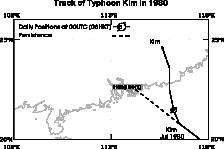
|
Figure 5 (a)
|
|
Figure 5 (b)
|
|
Figure 5 (c)
|
|
Figure 5 (d)
|
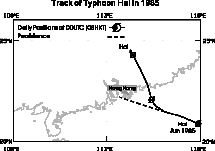
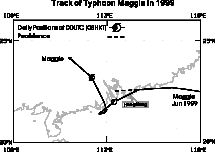
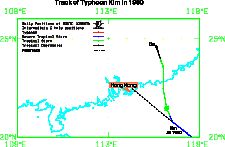
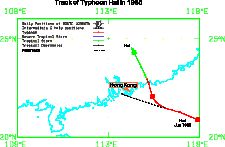
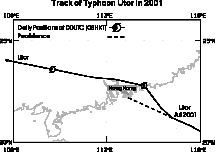
(ii) Longer range forecasting
Longer-range forecasting of landfalling TCs is also important. Some coastal areas have developed to such an extent that much longer than 12 hours are needed for TC preparations. For example, Southeast Louisiana (including New Orleans), Southeast Florida (including Miami and Ft. Lauderdale), and the Delmarva Peninsula (including Ocean City, Maryland) all need 36 hours or more to respond to the more powerful TCs. Although track forecasting has improved dramatically at the longer time periods (section 5.3.2(a)), additional track improvements are required to minimize the areas needing to respond. This becomes imperative as population increases rapidly in many coastal communities.
- TC Intensity Prediction
Advancement in operational TC intensity prediction is lagging behind improvement in TC track forecasting. As discussed by C. Guard at the IWTC-IV (1998), most of the numerical and statistical models have only modest skill in predicting TC intensity for the 24- and 48-hour forecast period and nearly no skill beyond 48 hours. In many NMSs and TCWCs, the Dvorak analysis technique (Dvorak 1984) remains the primary operational tool for estimating TC intensity over data-sparse oceans. In this regard, the use of the satellite scatterometer data (e.g. QuikScat, SSM/I) has potential for providing a Dvorak-like intensity estimation technique. Forecasters could benefit from these latest developments by cross-checking the available wind distributions with the synoptic observations and satellite / radar images when estimating the TC intensity (Lam 2001, Bankert 2002). Latest researches also reveal that more accurate determination of the TC initial conditions could lead to better TC track and intensity predictions (Chan and Kwok 1997; Nagata et al. 2001). Effective assimilation of the QuikSCAT and SSM/I wind data as well as other remotely sensed data into NWP may help to improve the TC track and intensity forecast of numerical models (Sakai et al. 2002).
- Impact of Internet
Internet users are expanding at a phenomenal rate and an increasing percentage of users are having broadband connection. This gives NMSs a good opportunity to further expand their service and educate the public on weather hazards. However, the internet is also flooded with weather information from many different organizations and information service providers. Unavoidably, some of the information may conflict with others and bewilder the public. It is a non-trivial task for NMSs to ensure their official warnings/forecasts can be authoritatively conveyed to the public and to clarify any rumor or confusion arising from “unofficial” sources. It is also very dangerous to rely only on the internet as a means of dissemination. The U.S.A. NHC’s website was not updated for nearly 24 hours in 2002 as a result of a telephone company problem.
Although the internet is growing fast, there is still a large population without internet access. Care must be taken to ensure that the quality of TC warnings is not polarized into those that have access to the internet and those that have not.
- Summary
On the meteorological side, research supports are required to improve the skill of both track and intensity forecasting of TCs. Satellite radiometry and scatterometer data have the potential to improve TC track and intensity forecasting provided they are suitably employed in numerical modelling and nowcasting systems.
The advance of internet and mobile communication technology has significant impact on warning dissemination and information exchange. As regards warning production and external liaison, it is noted that many NMSs are consciously shifting from a predominantly science-centred approach to a more user-oriented one. Nurturing partnerships with the media and emergency services is seen as an integral part of this change in corporate strategy.
Bibliography:
Aberson, S. D., Lord, S. J., DeMaria, M., and Tracton, M. S., (1995). Short-range ensemble forecasting of hurricane tracks. In Preprints, 21st Conf. Hurr. Trop. Meteorol., Miami, Am. Meteorol. Soc., 290-292.
Aberson, S. D., (2001). The ensemble of tropical cyclone track forecasting models in the North Atlantic Basin (1976-2000), Bull. Amer. Meteor. Soc., 82 , 1895-1904.
Bankert, R. L., and Tag, P. M., (2002). An automated method to estimate tropical cyclone intensity using SSM/I Imagery. J. Appl. Meteorol., 41, 461–472.
Bell, G. J., (1979). Operational forecasting of tropical cyclones: past, present and future. Aust. Meteorol. Mag., 27: 249-258.
Blackwell, K. G., (2000). The evolution of hurricane Danny (1997) at landfall: Doppler-observed eyewall replacement, vortex contraction/intensification, and low-level wind maxima. Mon. Wea. Rev., 128, 4002-4016.
Carr, L. E., III, and Elsberry, R. L., (2000). Dynamical tropical cyclone track forecasting errors. Part I: Tropical region error sources. Wea. Forecasting, 15, 641-661.
Carr, L. E., III, and Elsberry, R. L., (2001). Notes and Correspondence: Beta test of the systematic approach expert system prototype as a tropical cyclone track forecasting aid. Wea. Forecasting, 16, 355-368.
Chan, J. C. L., and Kwok, R. H. F., (1997). A diagnostic study on the improvement in tropical cyclone motion prediction by the UK Met. Office Global Model, Meteorol. Appl. 4. 1-9.
Cheng, C. M., Tsui, K. C., and Lee, B. Y., (2000). Landfalling Tropical Cyclones near Hong Kong in 1999 and 2000, WMO Regional Technical Conference on Tropical Cyclones and Storm Surges, Chiang Mai, Thailand, 13-17 November 2000
Cheung, K. K. W., (2001). A review of ensemble forecasting techniques with a focus on tropical cyclone forecasting. Meteorol. Appl. 8, 315-332.
Chu, J. H., (1994). A Regression Model for the Western North Pacific Tropical Cyclone Intensity Forecast. Naval Res. Lab., Monterey, CA. NRL/MR/7541--94-7215. 33 pp.
DeMaria, M., and Kaplan, J., (1994). A statistical hurricane intensity prediction system (SHIPS) for the Atlantic basin. Weather and Forecasting, 9, 209-220.
Dube, S. K., Sinha, P. C., Rao, A. D. and Rao, G. S., (1985). Numerical modeling of storm surges in the Arabian Sea. Appl. Math. Modeling, 9, 289-294.
Dvorak, V. F., (1975). Tropical cyclone intensity analysis and forecasting from satellite imagery. Mon. Wea. Rev., 103, 420-430.
Fitzpatrick, P., (1997). Understanding and forecasting tropical cyclone intensity change with typhoon Intensity Prediction Scheme (TIPS). Weather and Forecasting, 12, 826-846.
Ghosh, S. K., (1977). Prediction of storm surges on the East Coast of India, Ind. Jourl. Met. Hyd. And Geophy, 29(2), 157-168.
Goerss, J. S., (2000). Tropical cyclone track forecasts using an ensemble of dynamical models. Mon. Wea. Rev., 128, 1187-1193.
Heming, J., (2000). Tropical cyclone forecasting – the last decade. NWP Gazette, June, 4-5.
Houston, S. H., Shaffer, W. A., Powell, M. D., and Chen, J., (1999). Comparisons of HRD and SLOSH surface wind fields in hurricanes: Implications for storm surge forecasting. Wea. Forecasting, 14, 671-686.
Imaoka, K, and Spencer, R. W., (2000). Diurnal variation of precipitation over the tropical oceans observed by TRMM/TMI combined with SSM/I. J. Climat., 13, 4149–4158.
Jarvinen, B. R, and Neumann, C. J., (1979). Statistical forecasts of tropical cyclone intensity for the North Atlantic Basin. NOAA Technical Memorandum NWS NHC-10. 22 pp.
Jelesnianski, C. P., Chen J., and Shafer, W. A., (1992). SLOSH : Sea, lake, and overland surges from hurricanes. NOAA Technical report NWS 48.
JMA, (1998). Annual Report on Activities of the RSMC Tokyo – Typhoon Center. Japan Meteorological Agency, 98 pp.
Kalsi, S. R., Roy Bhowmik, S. K., Gupta, D. C. and Nath, S. M., (2002). Development of super cyclone of Orissa and its impact, Proceedings of the national symposium TROPMET-2001, Indian Meteorological Society, Mumbai, India, February, 2001, 60-67.
Kidder, S. Q., Goldberg, M. D., Zehr, R. M., Demaria, M., Purdom, J. F. W., Velden, C. S., Grody, N. C. and Kusselson, S. J., (2000). Satellite analysis of tropical cyclones using the Advanced Microwave Sounding Unit (AMSU). Bull. Amer. Met. Soc., 81, 1241-1259.
Lai, E. S. T., (1999). TREC application in tropical cyclone observation. In ESCAP/WMO Typhoon Annual Review 1998, 135-139, Typhoon Committee Secretariat, Manila.
Lam, C.C., (2001). Performance of the ECMWF model in forecasting the tracks of tropical cyclones in the South China Sea and parts of the western North Pacific. Meteorological Applications, Vol. 8, 339-344.
Lam, C. Y., (2000). Tropical cyclone warning system in Hong Kong. Regional Technical Conference on Tropical Cyclones and Storm Surges, Chiang Mai, Thailand, 13-17 November, 2000.
Lam, C. Y., (2001). Tropical cyclone forecasting : Linkage between theory and practice, WMO Workshop on Typhoon Forecasting Research, Jeju, Korea 25-28 September 2001
Lam, H. K., (2001). The World Meteorological Organization Pilot Websites: “Severe Weather Information Centre” and “World Weather Information Service”, 34th Session of the ESCAP/WMO Typhoon Committee.
Lee, T. C., and Wong, M. S., (2002). The use of multiple-model ensemble techniques for tropical cyclone track forecast at the Hong Kong Observatory. To be presented at the WMO technical conference on data processing and forecasting systems, Cairns, Australia, 2-3 Dec. 2002.
Li, P. W., Wong, W. K., and Lai, E. S. T., (1999). Short-range forecast of heavy rain based on radar echo analysis. Presented at 3rd Int. Conf. on the Global Energy and water Cycle, June 1999, Beijing.
Mileti, D. S., and Sorenson, J. H., (1990). Communication of emergency public warnings – A social science perspective and state-of-the-art assessment, Oak Ridge National Laboratory, ORNL-6609, Oak Ridge, Tennessee, USA.
Nagata, M., Leslie, L., Kurihara, Y., Elsberry, R. L., Yamasaki, M., Kamahori, H., Abbey Jr, R.., Bessho, K., Calvo, J., Chan, J. C. L., Clark, P., Desgagne, M., Hong, S. Y., Majewski, D., Malguzzi, P., McGregor, J. ,
Mino, H., Murata, A., Nachamkin, J., Roch, M., and Wilson, C., (2001). Third COMPARE Workshop: A model intercomparison experiment of tropical cyclone intensity and track prediction. Bulletin of the American Meteorological Society: Vol. 82, No. 9, 2007–2020.
Sakai, R., Mino, H., and Nagata, M., (2002). Verifications of tropical cyclone predictions of the new numerical models at JMA, Technical Review No.5, Japan Meteorological Agency, March 2002.
Tam, K. H., (1996). Tropical cyclone and storm surge risk assessment, Seminar on Meteorological and Hydrological Hazard Assessment, New Delhi, India, 16-19 March 1996.
Tuttle, J. D., and Gall, R. L., (1999). A single-radar technique for estimating the winds in tropical cyclones. Bull. Amer. Meteor. Soc., 80 , 653-668.
Watson, C., and Johnson, M. E. (1999), Proceedings of the 23rd Conference on Hurricanes and Tropical Meteorology, 10-15 Jan. 1999, Dallas, TX by the AMS, Boston MA.
World Meteorological Organization, (1989). Human response to tropical cyclone warnings and their content, Report No. TCP-11.
World Meteorological Organization, (1990). Tropical cyclone warning systems. WMO/TD-No. 394, Report No. TCP-26.
World Meteorological Organization, (1998), Tropical Meteorology research Programme report Series, Report No, 59, Topic chairman and rapporteur reports of the fourth WMO International Workshop on Tropical Cyclones (IWTC-IV), Haikou, China, 21-30 April, 1998.
World Meteorological Organization, (1999). Tropical cyclone-related NWP products and their guidance. WMO/TD-No. 966, Report No. TCP-41.
World Meteorological Organization, (2002). Draft “Guidelines on improving public understanding of and response to warnings”, compiled by Christine Alex, Linda Anderson-Berry and Jim Davidson (to be published).
Yeh, Hsi-Chyi., Chen, G. T. J., Liu, W. T. (2002). Kinematic characteristics of a Mei-yu front detected by the QuikSCAT Oceanic Winds. Mon. Wea. Rev., 130, 700–711.
Zhang, Z., and Krishnamurti, T. N., (1997). Ensemble forecasting of hurricane tracks. Bull. Am. Meteorol. Soc., 78: 2785-2795.
#










